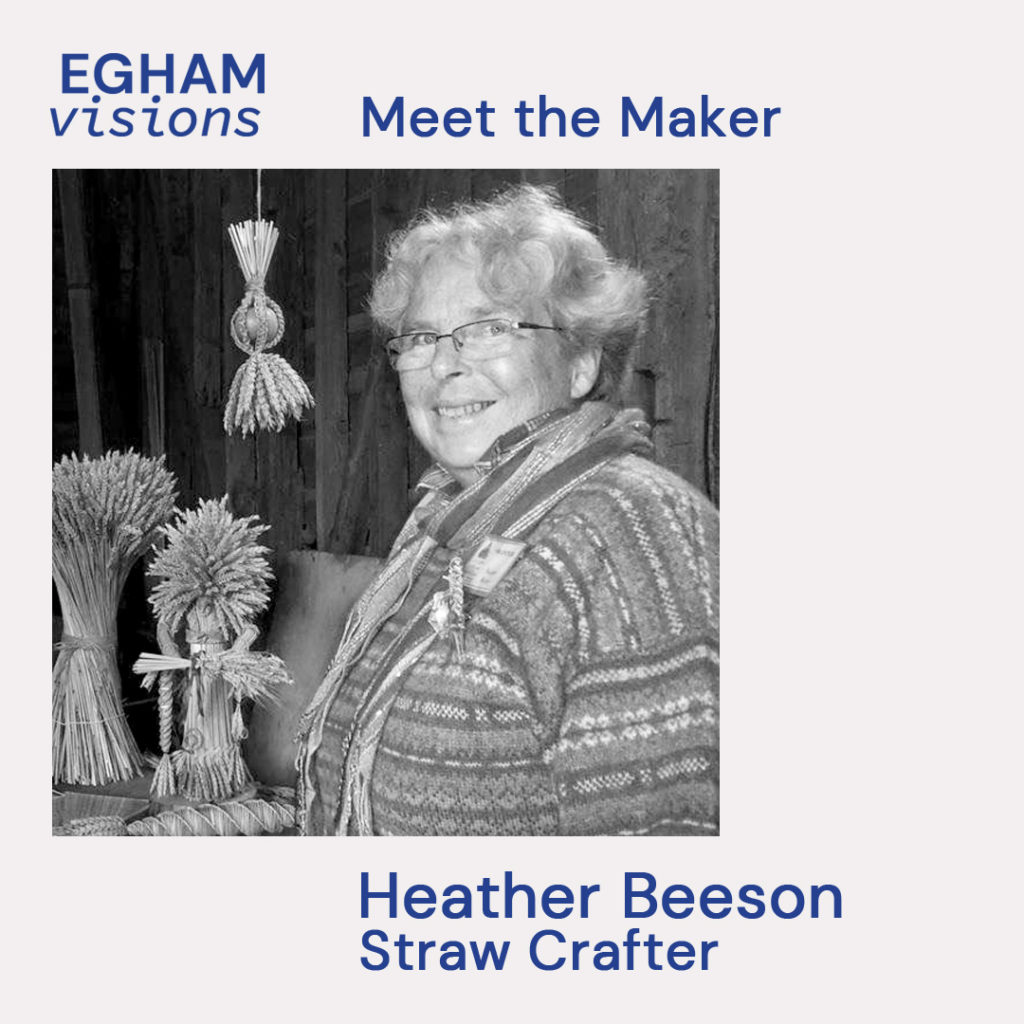
Maker: Heather Beeson, Straw Crafter
Interviewed by artist Estella Castle
What first attracted you to the craft?
I discovered that both my husband and I had straw plait makers in our families in the 1800’s and because I loved doing crafts and art I just wanted to feel the straw and feel how they plaited so that I could relate to them. So I went to the Guild of Straw Craftsmen meetings and asked them if I could make a hat. I never actually made a hat in the end, but I learned so much about working with straw and did so many other things that not making a hat didn’t matter really. I occasionally demonstrate straw hat making at the museum where I am a volunteer (the Chiltern Open Air Museum) but I’ve never made a straw hat yet.
So you reached out to them to learn how to make hats but you ended up going down a different path?
It takes a long time to make enough plait, but then you have to have the right equipment to enable you to make a hat. So it’s not as easy, for example as making a rush hat, which I have done, I’ve made several rush hats. For me it doesn’t matter that I haven’t made a complete straw hat.
What do you like about the material?
I love the feel of it and the look of it. Somebody recently said to me, “have you ever thought about the sound it makes when you plait?”. And I hadn’t, but there is a sound to it, if you are very, very quiet there is a very faint sound to it, which I’d never thought about. I love the feel of it and the look of it and what you can do with a damp piece of straw. When it’s dry you couldn’t begin to believe that you could do all of these things with it.
What relevance and benefits do you think the craft has that might attract a new generation of straw-crafters?
I think it’s just an amazing material that is very undervalued. Unfortunately it has rather an old fashioned image which we are trying to alter. Yes, we are trying to show the traditional side of using straw but also the newer and more innovative ways, simply the huge variety of ways that you can use straw to create different things.
What other uses and roles could the craft have today?
I think it’s a good therapy in a way because I did some straw plaiting on a mindfulness evening at the museum and the people that came and sat with me and had a go, just said it was wonderful, it takes you somewhere different, you can lose yourself. So in a way it’s a very calming gentle thing to do and I think it could help people to just relax and take themselves away from their real life. But then it could be that artists might find they can combine it with other materials. Like when I worked with Laura Copsey on her Masters project. Also as we are trying to show on our Straw Talk Facebook Group (http://www.facebook.com/groups/1101922423495189/), it doesn’t have to be just straw it can be combined with all sorts of things and all sorts of materials.
What designs are popular at the moment do you find? What are popular with makers to create and what are popular to sell, such as the traditional Welsh Fan for example?
I love making those but I think they are part of the learning process, which then enable you to go off on tangents and to other dimensions. It’s difficult to say what is popular to make, I think a lot of it is a personal choice about where you want to go. Whether you want to try and recreate things that were made previously or put your own stamp on it, a bit like that Welsh fan I made with the rust in with it, it’s a difficult question to answer because I think making is also partly a personal choice. But when you sell, lots of people like horseshoes for weddings, or little favours as gifts. People love to buy them because they are something different.
What are you working on at the moment?
That’s really funny actually, because quite often I spend ages making items to raise money for the museum and I make plaits to get ready for the courses that I run and straw events. It’s only these last few months since I’ve really got into Straw Talk that I’ve been making things that have been in my mind for months and longer for some of them. So the felt piece for example I have had in my head for a couple of years but now I’ve done it. I’ve just made another mixed media piece too. Every now and then I do something for myself but it varies tremendously. I might be influenced by something that I’ve seen that Elaine’s made for example or something I’ve seen out of a book, but actually quite a lot of the time I spend getting ready to teach other people to share this craft.
That’s very similar to what Elaine was saying when I interviewed her, that she doesn’t have the time to make the things that she wants to make, she’s out there educating people (hyperlink to interview)
So ‘Straw Talk’ has made me think about sharing different ideas because one item I’ve just made involves a piece of flint, which of course down here in the Chilterns there is masses of. So I’ve created a piece combining flint and straw. I’ve also made what I call a family tree, it’s actually a vertical row of four different hearts made from four different plaits and then between them there are three little pairs of figures. there is myself and my husband, my sister and her husband and my niece and nephew and we are each holding something that is important to us. I make things for friends, for example I’ve made several horseshoes for friends weddings. In 2019 I did a very special thing for harvest. I decorated the Chiltern Open Air Museum (COAM)’s Henton Chapel with straw decorations and it was on Country File (a UK television show) along with other museum harvest and activities.
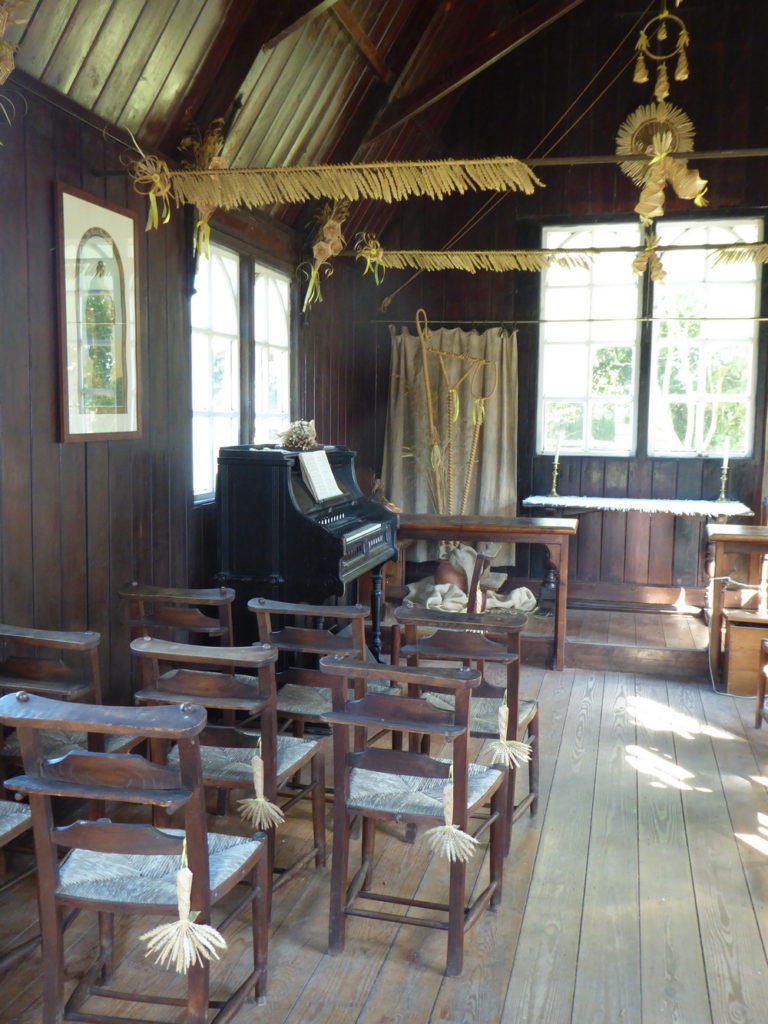
Henton Chapel COAM harvest festival 2019 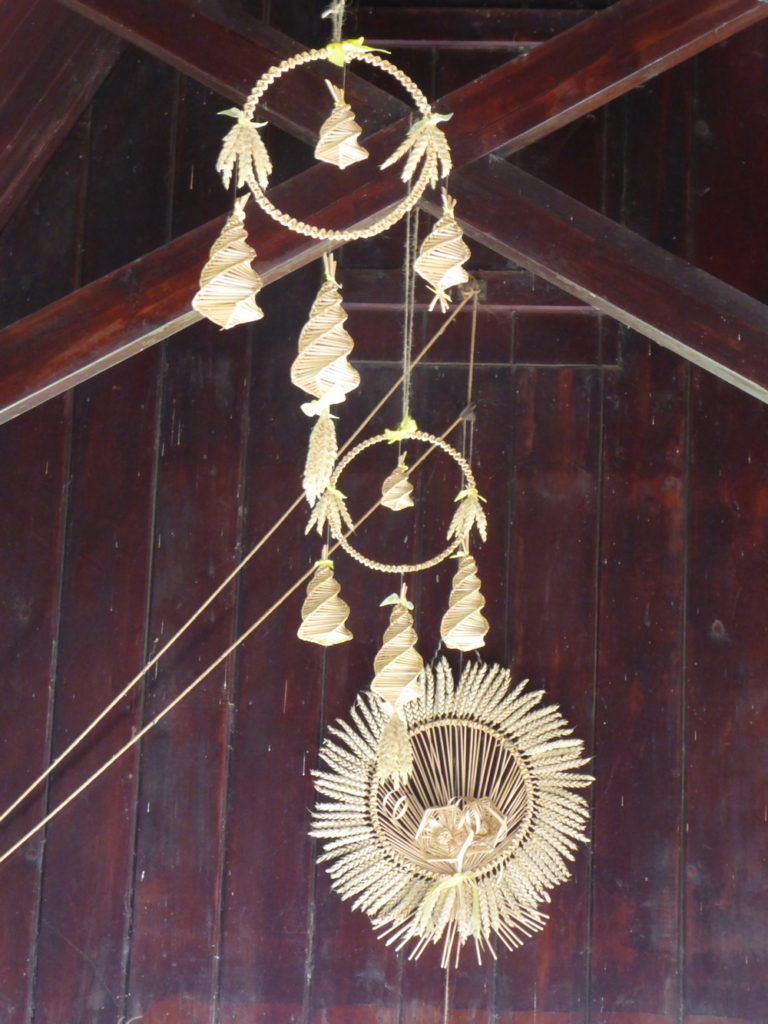
Henton Chapel COAM harvest festival 2019
What is something you haven’t made that you would like to make or an artist you would like to collaborate with.
One thing I’d like to make is Eastern European, in Belarus they make wonderful horses, I’d love to make one of those. If you google Belarus and Straw Work the most amazing work comes up. We were due to have a workshop at Strawfest in September 2020 making a simple one of these. I’d also like to make more flowers, a bigger variety and just create a huge vase of flowers of different sorts. Elaine inspires me, and some of the things she makes are quite amazing.
Can you look at photographs of straw-work and unpick how they have been made?
Some of them yes. I can quite often look at something and have a fair idea of how they have done it.
So when it comes to making your own forms and objects do you have to invent new plaits or do you use plaits already in use such as the‘five straw spiral plait?
I think a lot of my work is based on plaits and ways of using straw that I’ve learned and plaits that already exist or I’ve looked at a book and worked out how to do it and then put my own slant on it.
So say you want to make a form like a bird for example, do you then think about different plaits or techniques that you could use for different parts of the form?
I would look through a lot of the books and think about the plaits but I think I would probably look at a lot of different pictures too.
For example, my hairdresser asked me to make a pair of scissors for her as a decoration and I had to think about how on earth I was going to do that. Because you build up a knowledge of plaits and what you can do with straw you work out how you can create an object. I’ve made three pairs of scissors.
What advice would you give to someone starting out?
Don’t run before you can walk and enjoy it mainly. Ask if you’re not sure and if you can work with someone who knows a bit about the craft they will share their passion, and will enjoy teaching it and sharing it with you. simply, enjoy what you’re doing and be proud of what you make.
You have done a few collaborations with artists, what was that experience like?
It was really interesting actually. I really enjoyed it because it makes you think out of the box. I’ll go back to Laura and the rust piece, because I just loved that idea. As soon as I saw her rusty ring off a wooden barrel, that she’d found on the beach with its beautiful and texture. I just loved it paired with straw, and that’s what inspired me to do mine. You can learn so much from them (artists) I just love talking to them. Three of the people I’ve worked with have come to my home and hopefully you will one day. It’s just a joy to see them soak up the love of straw and enjoy using it. They think of things you don’t because they are coming from a different angle. I think that’s an interesting part of it, that they see things through their own personal art and will ask how do I do this or how do I do that, It just makes me think out of the box.
What resources would you recommend?
Well the simplest things are strong thread and a pair of scissors and you can do a lot with just those. There are tools that you collect that enable you to do more complicated things. For example a metal dog comb, enables you to make little straw leaves that you can then decorate things with. You gradually build up other items such as straw splitters, a tool called a hindenburg that you can soften and split straws with, and needles. From a tools point of view it’s not that complicated.
Other resources, the Guild of Straw Craftsmen have some projects with clear instructions. Going to straw events, such as ‘Strawfest’ and ‘Straw in the North’ and there are a couple of other groups that get together. There is a group near Banbury that meets three times a year, that’s where I started and I also now run my own group as well as the courses at COAM.
You do need to use heritage varieties of straw and these are available from specialist growers. These old varieties grow much taller than the modern ones and so the straws are much longer.
You also volunteer at Chiltern Open Air Museum, an open air rural museum. What do you think the value of places like that is? Do they teach other historic crafts as well as the straw craft workshops you lead?
The museum is hugely valuable in teaching people about the past, the Chiltern building styles and the people who lived and worked in the buildings. At COAM they have blacksmith workshops and historical cooking as well as willow courses and my straw courses.
How does that relate to the craft that you do, what is important about these workshops? You obviously have quite a keen interest in teaching people about rural crafts but you also volunteer there in the gardens.
I also work with the farm team, that’s how I started really and trying to show the historical ways of farming and then I got into straw. We have tried to link the two together. At harvest time when we have all the threshing and other harvest activities going on I will demonstrate making things from straw. But then also one of the buildings used to be lived in by straw plait makers, so that enables me to have a day where I will demonstrate straw plait making and talk about the local straw hat industry.
How do the visitors react to that?
They’re really, really interested. You do get people who know a bit who have memories and they might recall that one of their relations in the past used to be a straw plait maker and all sorts of information comes out.
That’s really interesting Heather because I think it grounds people to their local area. To experience and learn about straw plait making, then see the house that these makers used to live in to then being able to have a go themselves, it really ties them back to the land.

‘Family’ 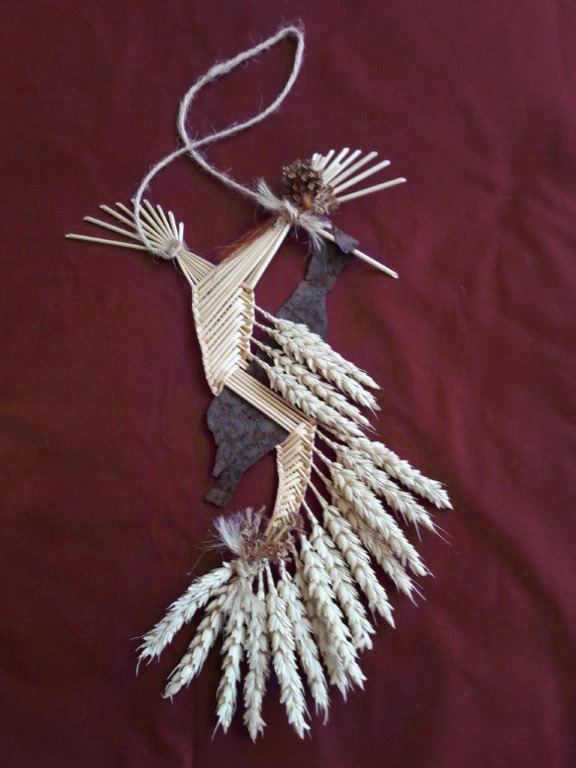
Welsh Fan and Rust 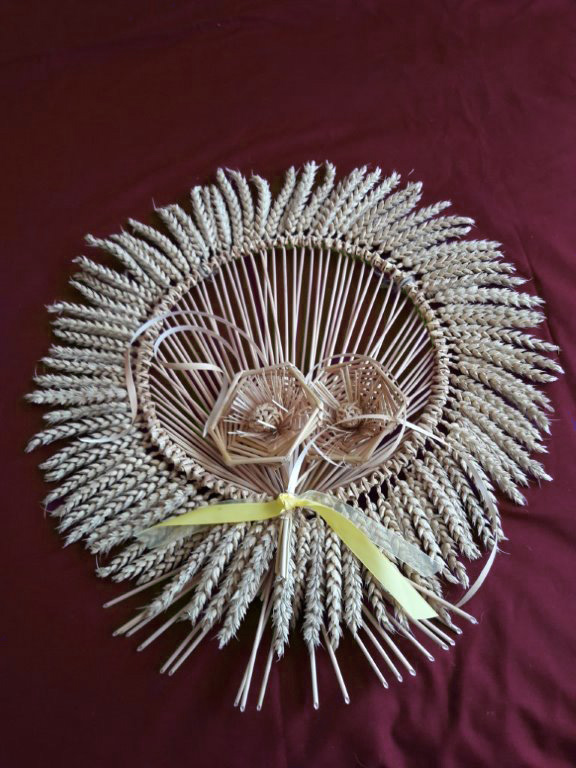
‘Sun with Poppies’ 
The Dancing Girls 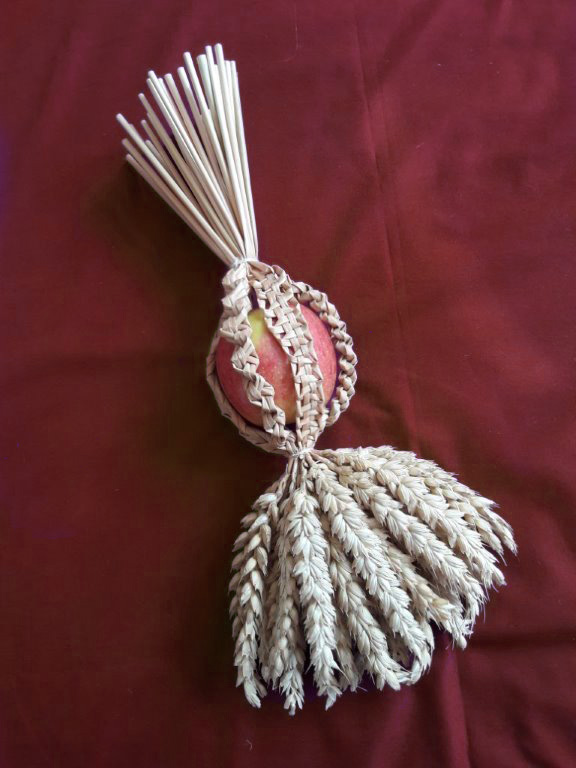
Corn Dolly Mel 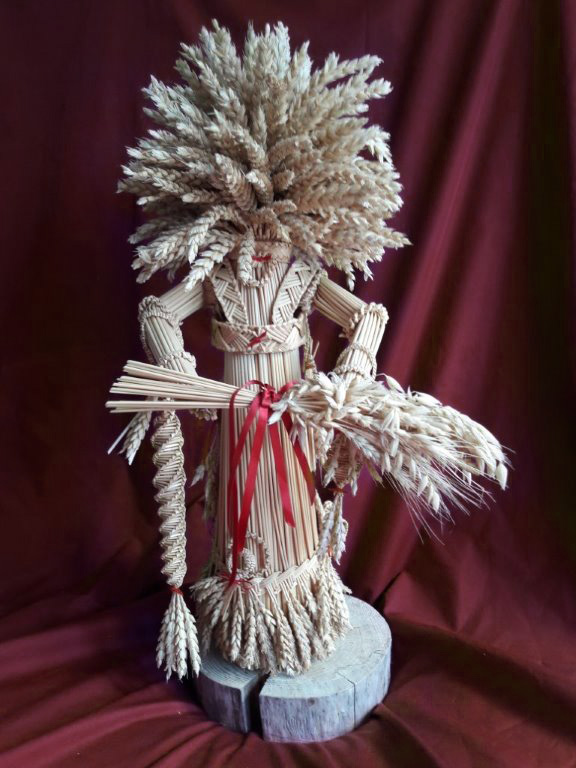
Flora
